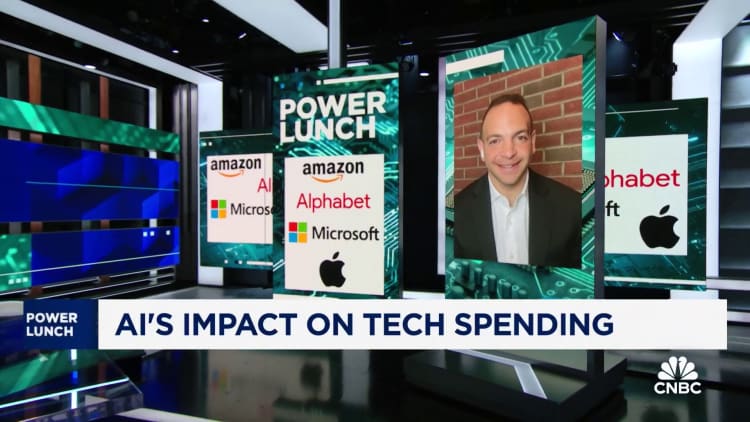AI hiring frenzy to fuel layoffs in other tech segments this year

Stick figures image displayed on a laptop screen and a binary code displayed on a phone screen are seen in this illustration photo taken in Krakow, Poland on January 24, 2023. (Photo by Jakub Porzycki/NurPhoto via Getty Images)
Nurphoto | Nurphoto | Getty Images
As tech firms prioritize investments into artificial intelligence and go on a hiring spree, other segments are likely to see layoffs continue into 2024, according to industry experts.
More than 20,000 tech employees have already lost jobs so far in 2024, according to tracker layoffs.fyi.
“Google and the rest of Big Tech are betting big on AI while cutting back on non-strategic areas. Layoffs will continue to happen for Big Tech in some areas while the hiring frenzy in AI will be unprecedented as this arms race continues across the tech world,” Dan Ives, managing director at Wedbush Securities, told CNBC.
Google CEO Sundar Pichai last week warned employees there would be more job cuts this year as the company continues to shift investments toward AI.
“We have ambitious goals and will be investing in our big priorities this year,” Pichai wrote in a Jan. 17 memo to employees, adding that the management was gearing up to share its AI goals and objectives for 2024. “The reality is that to create the capacity for this investment, we have to make tough choices,” Pichai said.
Google slashed hundreds of jobs earlier this month in its push for efficiency and to focus on its “biggest product priorities,” as it plays catch up with rival Microsoft which has integrated ChatGPT into Bing search, and prompted Google to beef up its search engine with AI features.

“We’re not living in a zero interest rate environment anymore. And now they really need to find ways to cut costs so they can invest here. Training AI, deploying AI is very expensive. And I think that’s what’s happening with Google today,” said Alex Kantrowitz, Big Technology founder, on CNBC’s “Power Lunch” last week.
“That is something that I expect other Big Tech companies to follow,” said Kantrowitz on Jan. 18.
German enterprise software firm SAP on Tuesday announced it would restructure about 8,000 roles to “increase its focus on key strategic growth areas, in particular business AI” in 2024.
“The majority of the approximately 8,000 affected positions is expected to be covered by voluntary leave programs and internal re-skilling measures,” the company said, adding that headcount should still be the same by year-end.
Amazon, which has been aggressively investing in AI, laid off hundreds of employees in its video-streaming and studio divisions earlier this month. Jobs were also cut in its Twitch livestreaming platform and Audible audiobook unit.
Mike Hopkins, who oversees Prime Video and MGM Studios divisions, said that the firm has “identified opportunities to reduce or discontinue investments” while increasing investment in other areas that deliver the most impact.
Amazon Web Services, the e-commerce giant’s cloud service business, said on Jan. 19 it would likely pump 2.26 trillion yen ($15.24 billion) in Japan by 2027 to expand cloud computing infrastructure that is key for AI services.

Job cuts not limited to tech
Other companies too are looking to cut jobs to focus on their AI-driven businesses.
Vroom would axe about 800 jobs, according to the U.S.-based online used-car marketplace’s regulatory filing last week, as it plans to focus on automotive financing and AI services and close its e-commerce and used-vehicle dealership businesses.
Earlier this month, media reports said Duolingo would cut 10% of its contractors as the language-learning app moves toward using AI to create content.
“A couple of years ago, what [firms] would have done is just hire away … and not worry about where they had to cut previously. But that’s gone,” said Kantrowitz.
Mass layoffs began in 2022 and extended through 2023 as global macroeconomic headwinds such as high interest and inflation rates caused consumers to pull back on spending amid uncertainty in the global economy.




